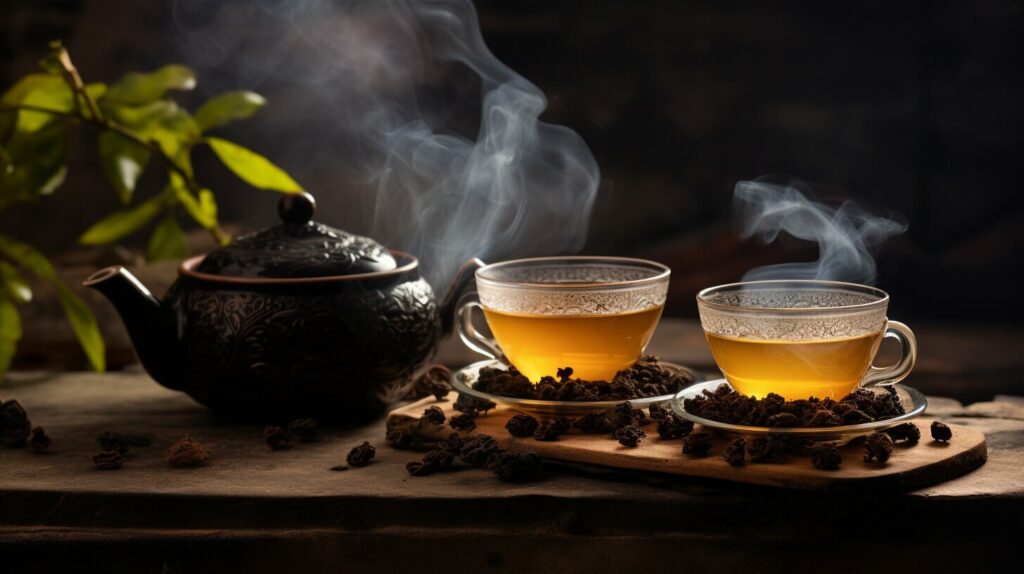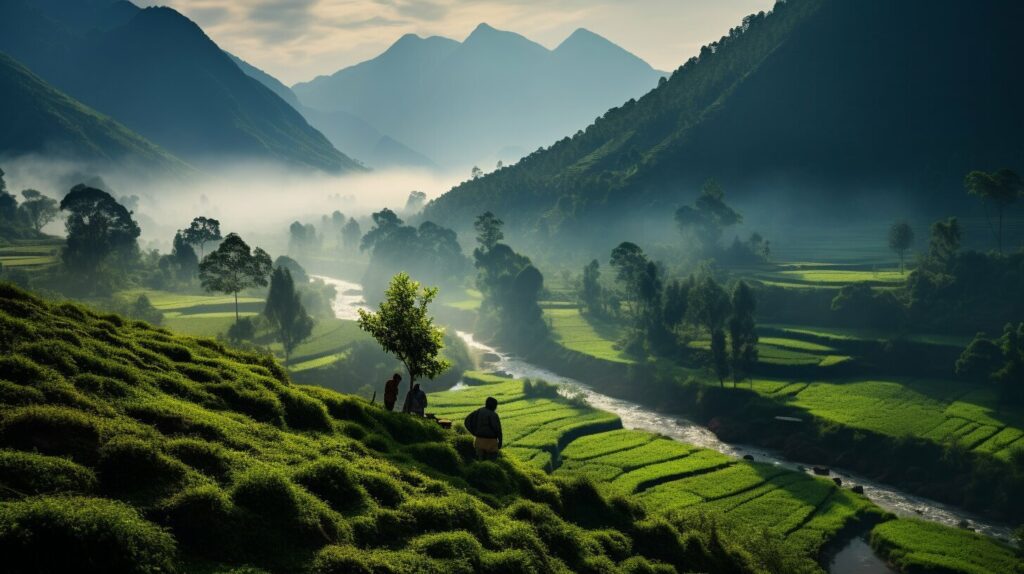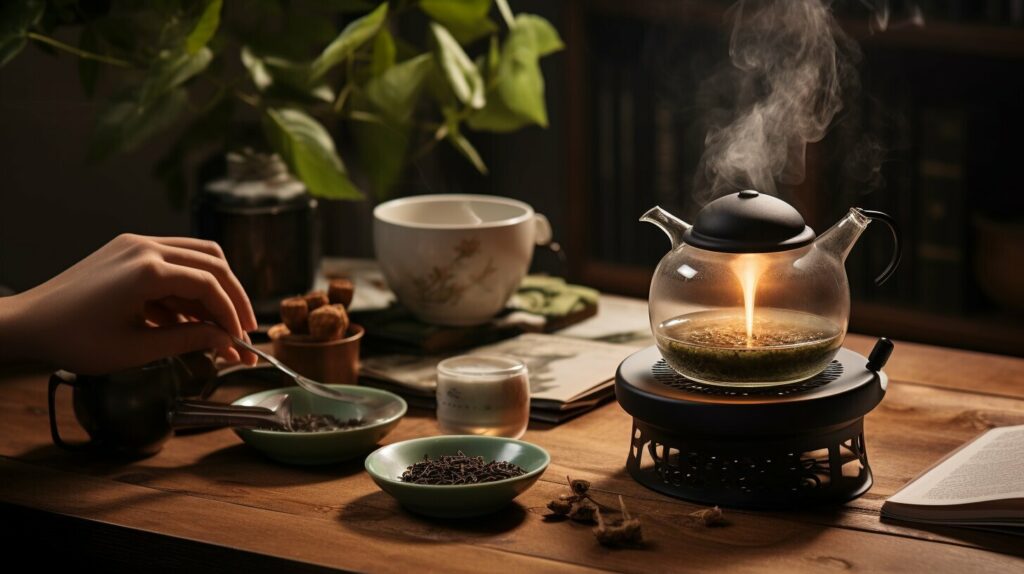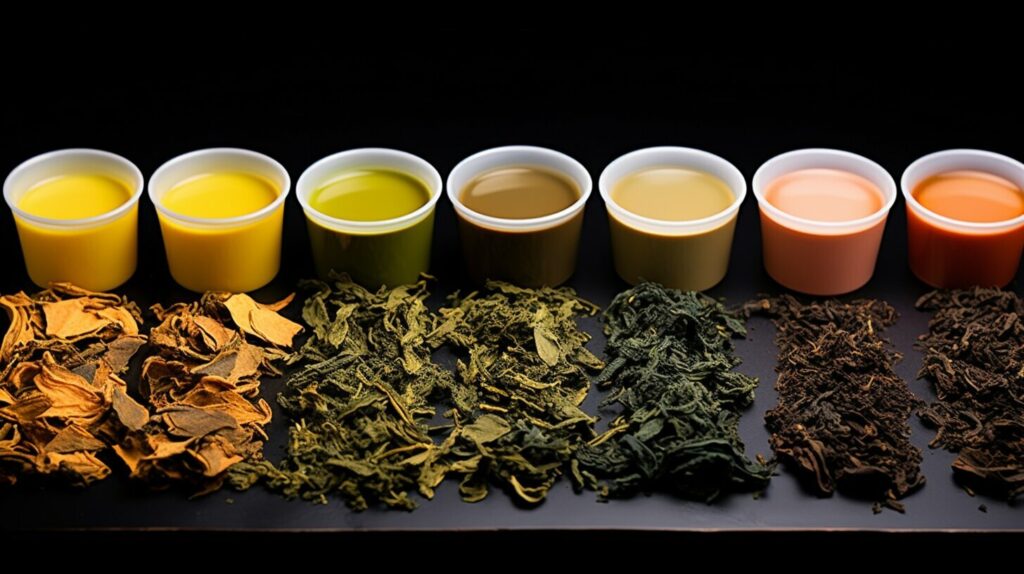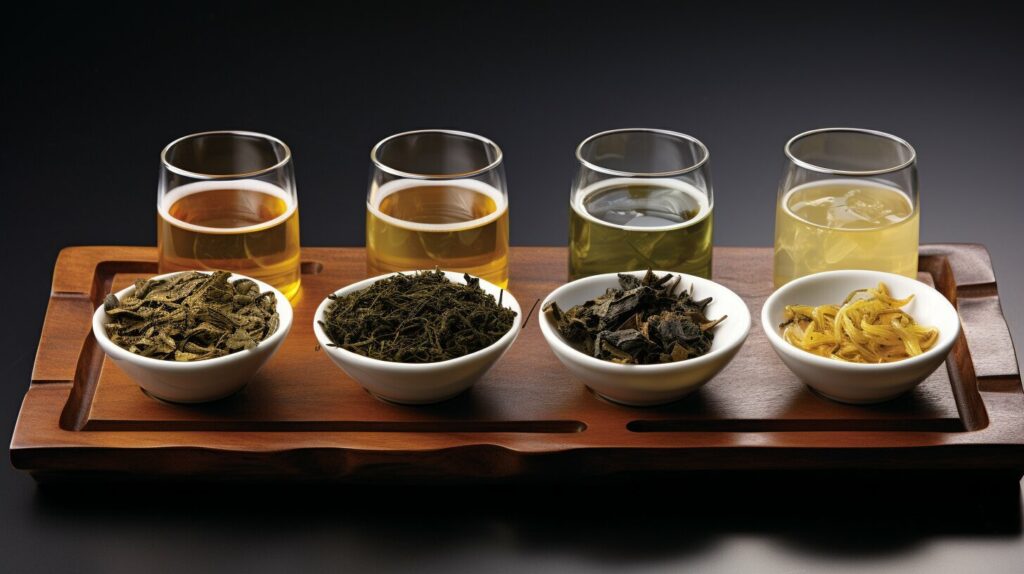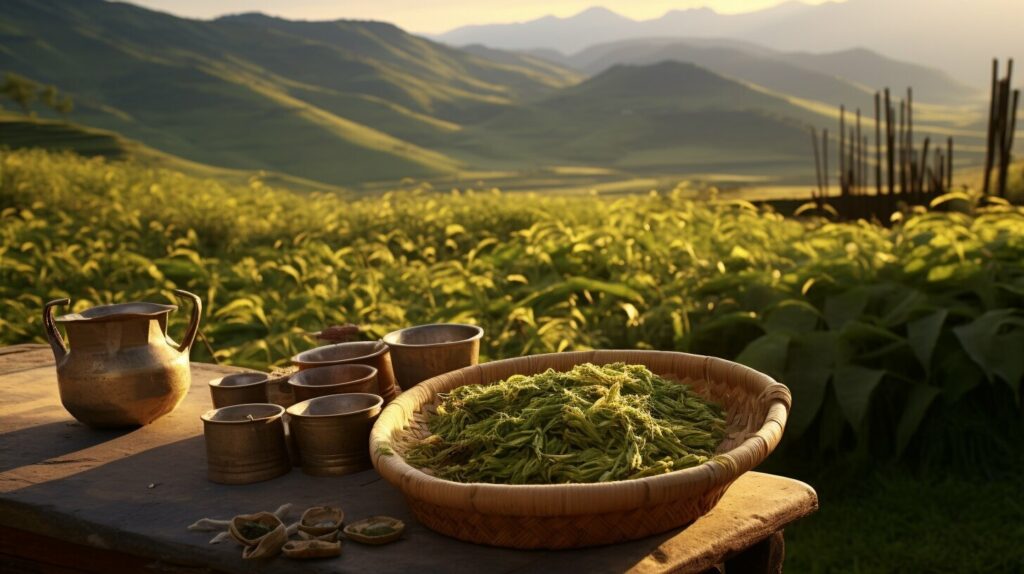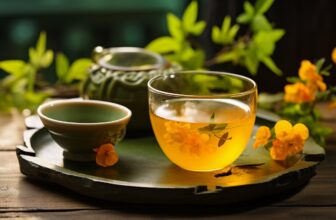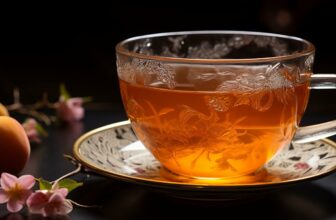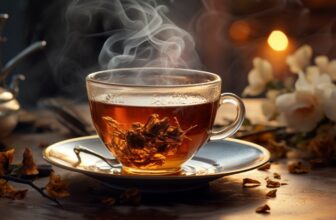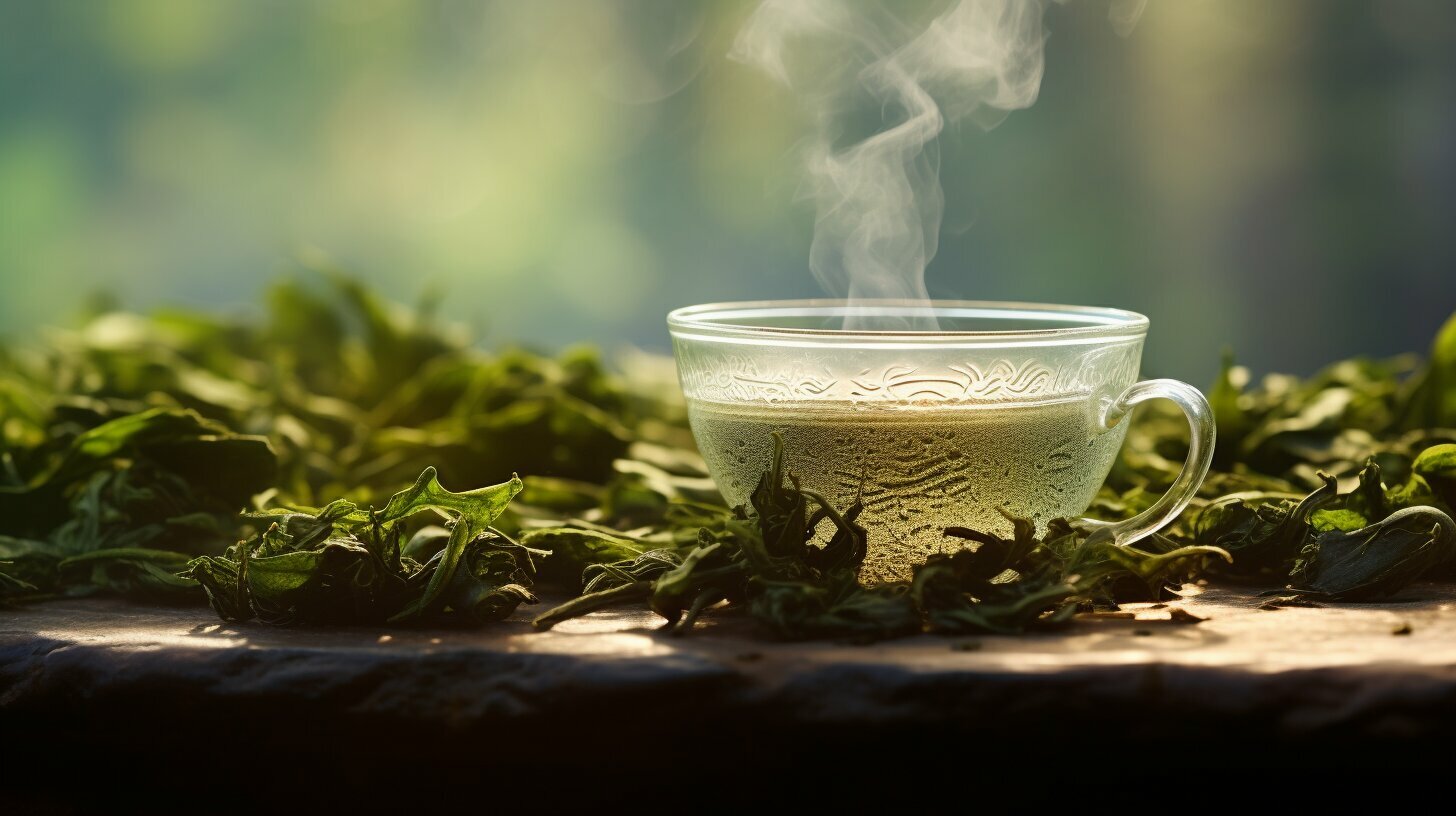
When it comes to tea, there are countless varieties to choose from, each with its own unique flavor profile. One such variety that stands out is oolong tea. But what exactly does oolong tea taste like, and is it delicious? Let’s explore the delightful flavor of oolong tea.
Key Takeaways:
- Oolong tea falls between green and black tea in terms of oxidation, giving it a unique flavor.
- The taste of oolong tea can vary, with some varieties having fruity notes, while others have floral undertones.
- Many people find the taste of oolong tea to be delightful, making it one of the most popular teas in the world.
- Exploring different types and varieties of oolong tea can lead to a journey of discovering new flavors and aromas.
- Oolong tea is known for its subtle complexities and delightful aromas, making it a favorite among tea enthusiasts.
The Production Process of Oolong Tea
Oolong tea, with its unique flavor profile, undergoes a carefully crafted production process. Made from the leaves of the Camellia sinensis plant, oolong tea falls between green and black tea in terms of oxidation. Its distinct flavor is a result of the oxidation process, where the leaves are exposed to oxygen.
The production of oolong tea involves several steps: withering, rolling, and oxidation. During withering, the freshly picked tea leaves are spread out and left to wilt naturally or with the assistance of fans. This process helps reduce the moisture content and prepare the leaves for rolling. Rolling is the next crucial step, where the withered leaves are gently rolled to break down their cell walls and release enzymes. This rolling action helps initiate the oxidation process.
Oxidation, a defining step in oolong tea production, determines the flavor profile of the tea. The leaves are left to oxidize, either naturally or through controlled environmental conditions. The length of oxidation can vary, resulting in different levels of intensity and flavor. Some oolongs are lightly oxidized, offering delicate floral notes, while others are more heavily oxidized, showcasing rich fruity or roasted flavors.
After oxidation, the leaves undergo a final step of roasting and drying. This step halts the oxidation process and ensures the leaves are ready for brewing. The roasting imparts additional depth and complexity to the flavor, while the drying removes any remaining moisture. The end result is a beautifully crafted oolong tea ready to be enjoyed.
| Step | Description |
|---|---|
| Withering | Freshly picked tea leaves are spread out and left to wilt naturally or with the assistance of fans to reduce moisture content. |
| Rolling | Withered leaves undergo gentle rolling to break down their cell walls and release enzymes, initiating the oxidation process. |
| Oxidation | Leaves are left to oxidize naturally or under controlled conditions, resulting in varying levels of intensity and flavor. |
| Roasting and Drying | The leaves are roasted to add depth and complexity to the flavor, and then dried to remove any remaining moisture. |
The Benefits of Drinking Oolong Tea
Oolong tea is not only a delicious beverage but also offers numerous health benefits. Regular consumption of oolong tea can contribute to improved digestion, weight loss, and reduced cholesterol levels. Additionally, oolong tea is rich in antioxidants, which help protect the body against free radicals and boost the immune system.
One of the key benefits of oolong tea is its potential to aid in weight loss. Studies have shown that oolong tea can increase metabolism and fat oxidation, making it a valuable addition to a healthy diet and exercise routine. Oolong tea can also help regulate blood sugar levels, reducing cravings for sugary foods and helping to maintain a balanced diet.
Another advantage of oolong tea is its ability to promote relaxation and reduce stress. The combination of amino acids and caffeine in oolong tea can have a calming effect on the body, helping to alleviate symptoms of anxiety and tension. Enjoying a cup of oolong tea can provide a soothing break from a busy day and help restore a sense of calm.
Table: Health Benefits of Oolong Tea
| Health Benefit | Description |
|---|---|
| Improved Digestion | Oolong tea can help stimulate digestive enzymes, aiding in the breakdown of food and promoting better digestion. |
| Weight Loss | Regular consumption of oolong tea can boost metabolism and fat oxidation, contributing to weight loss. |
| Reduced Cholesterol Levels | Oolong tea has been found to help lower LDL cholesterol levels, reducing the risk of heart disease. |
| Antioxidant-Rich | Oolong tea is packed with antioxidants, which help protect the body against free radicals and boost the immune system. |
| Promotes Relaxation | The combination of amino acids and caffeine in oolong tea can have a calming effect on the body, promoting relaxation and reducing stress. |
Furthermore, oolong tea has been linked to improved heart health and a reduced risk of tooth decay. The antioxidants in oolong tea can help prevent the formation of plaque and fight against the bacteria that cause cavities. Regularly enjoying a cup of oolong tea can contribute to a healthier smile and overall oral health.
Overall, the benefits of drinking oolong tea extend beyond its delightful taste. From aiding in weight loss to promoting relaxation and improving heart health, oolong tea is a beverage that offers a wide range of advantages. Whether enjoyed hot or cold, oolong tea is a refreshing and healthful choice for tea lovers everywhere.
The Flavor Profile of Oolong Tea
Oolong tea offers a delightful taste experience with its complex flavor profile. The unique characteristics of oolong tea result in a wide range of flavors, allowing tea enthusiasts to explore a variety of taste profiles. The flavor of oolong tea can be influenced by factors such as oxidation level, regional origin, and brewing techniques.
One of the distinguishing features of oolong tea is its ability to offer fruity, floral, and even earthy notes. Some oolongs have a fruity taste, with hints of peach, apricot, or citrus, while others exhibit floral undertones, reminiscent of orchids or jasmine. There are also oolongs that have a more roasted or earthy flavor, with notes of caramel or toasted nuts. The taste experience of oolong tea is multi-layered, with each sip revealing new nuances and subtle flavors.
Reviews of oolong tea often highlight the enjoyable taste and complexity of this beloved beverage. Many tea enthusiasts appreciate the balance between the lightness of green tea and the richness of black tea that oolong offers. The taste of oolong tea can be both refreshing and comforting, making it a popular choice among tea lovers.
| Taste Profile | Description |
|---|---|
| Fruity | Oolongs with fruity notes, such as peach, apricot, or citrus flavors. |
| Floral | Oolongs with floral undertones, reminiscent of orchids or jasmine. |
| Roasted | Oolongs with a more roasted or earthy flavor, with hints of caramel or toasted nuts. |
The taste profile of oolong tea can vary across different varieties and regions. The oxidation level, which ranges from lightly oxidized to heavily oxidized, can greatly influence the flavor. Additionally, the terroir, climate, and processing techniques used in different regions contribute to the unique taste of oolong teas. Exploring the diverse flavor profiles of oolong tea is an exciting journey that allows tea enthusiasts to discover their personal preferences and appreciate the intricacies of this beloved beverage.
The Unique Origins of Oolong Tea
Oolong tea has a rich history that dates back centuries. It originated in China during the Ming Dynasty and was later introduced to Taiwan. The term “oolong” translates to “Black Dragon” in Chinese, which reflects the tea’s unique characteristics. Oolong teas have different regional origins, with some varieties originating in Fujian and Guangdong provinces in China, while others are cultivated in Taiwan. Each region has its own unique techniques and traditions for producing oolong tea, resulting in distinct flavor profiles.
Throughout its history, oolong tea has been carefully cultivated by skilled artisans who have passed down their knowledge and techniques from generation to generation. The art of producing oolong tea involves meticulous attention to detail and a deep understanding of the tea leaves and their unique characteristics. From the selection of the tea leaves to the precise timing of the oxidation process, every step in the production of oolong tea contributes to its distinct flavor and aroma.
The regional variations in oolong tea production also play a significant role in the flavor profile of the tea. The climate, soil composition, and elevation of the tea gardens all impact the growing conditions and, subsequently, the flavor of the tea leaves. For example, oolong teas grown in high-altitude regions like Taiwan’s mountains often have a more delicate and complex flavor profile compared to teas grown in lower-lying areas. The unique combination of terroir and craftsmanship is what makes oolong tea truly special.
Table 5 below provides a summary of the unique origins of oolong tea:
| Region | Origins |
|---|---|
| China – Fujian Province | Oolong teas from this region are known for their deep, roasted flavors with notes of orchid and mineral complexity. |
| China – Guangdong Province | Oolong teas from this region often have a floral aroma and a mellow taste, with hints of sweetness. |
| Taiwan | Taiwanese oolong teas are characterized by their delicate floral aromas, creamy texture, and complex flavors. |
Table 5: Unique Origins of Oolong Tea
The Influence of Climate on Oolong Tea Flavor
When it comes to the flavor of oolong tea, the climate in which it is grown plays a crucial role. The unique combination of temperature, humidity, and terroir in different regions can result in diverse flavor profiles and characteristics. One notable influence of climate on oolong tea flavor is the impact of high elevation cultivation.
High altitude regions, such as the mountains of Taiwan, are known for producing oolong teas with a distinct taste. The cooler temperatures and higher humidity in these areas create an environment that encourages the tea plants to develop more delicate and complex flavors. The slow growth rate and exposure to limited sunlight at higher altitudes contribute to the unique taste of high elevation oolong tea.
The terroir, which includes factors such as soil composition and sunlight exposure, also plays a significant role in oolong tea flavor. The specific conditions in each region contribute to the nuances and characteristics that make oolong teas from different areas truly unique. For example, oolong teas from Fujian province in China are known for their deep, roasted flavors with notes of orchid and mineral complexity, while Taiwanese oolongs often exhibit delicate floral aromas and a creamy texture.
| Climate Factors | Oolong Tea Flavor |
|---|---|
| Cooler temperatures | Delicate and complex flavors |
| Higher humidity | Enhanced aroma and texture |
| Limited sunlight | Unique taste development |
| Regional terroir | Distinctive flavor profiles |
Table: Influence of Climate on Oolong Tea Flavor
Exploring oolong teas from different regions can provide a captivating journey through diverse flavor profiles and taste experiences. Whether you prefer the rich and roasted flavors of Fujian oolongs or the delicate floral notes of Taiwanese varieties, the influence of climate on oolong tea flavor is undeniable. So, sit back, sip, and savor the unique taste of oolong tea, shaped by the climate and terroir of its origin.
The Art of Brewing Oolong Tea
When it comes to brewing oolong tea, attention to detail is key in order to fully capture its delightful flavors. Here are some tips on how to brew the perfect cup of oolong tea:
- Start with fresh, filtered water to ensure a clean taste.
- Measure approximately 2 grams of loose-leaf oolong tea per cup.
- Preheat your teapot or teacup by rinsing it with hot water.
- Bring the water temperature to around 185-205°F (85-96°C) for optimal extraction.
- Pour the hot water over the oolong tea leaves and let it steep for about 3 minutes, or adjust the steeping time based on your personal preference.
- Strain the tea to prevent overextraction and remove the leaves.
These brewing guidelines provide a good starting point, but feel free to experiment with the brewing time and water temperature to suit your taste. The beauty of oolong tea lies in its versatility, allowing you to customize the flavor profile based on your preferences.
Remember, brewing oolong tea is an art form that requires practice and patience. Take the time to savor each cup and appreciate the unique flavors that oolong tea has to offer.
Expert Tip:
“To enhance the flavor of oolong tea, try using a small teapot or gaiwan. These vessels allow for better heat retention and extraction, resulting in a more robust and flavorful brew.”
Recommended Oolong Teas for Brewing:
| Oolong Tea Variety | Flavor Profile | Recommended Brewing Time | Water Temperature |
|---|---|---|---|
| Tieguanyin | Aromatic with floral and fruity notes | 3-4 minutes | 185-205°F (85-96°C) |
| Da Hong Pao | Rich and roasted with hints of cocoa | 4-5 minutes | 185-195°F (85-91°C) |
| Dong Ding | Smooth and creamy with a floral aroma | 2-3 minutes | 195-205°F (91-96°C) |
Brewing oolong tea is a sensory experience that allows you to explore the diverse flavors and aromas of this beloved beverage. So sit back, relax, and enjoy the art of brewing oolong tea.
Popular Varieties of Oolong Tea
Oolong tea is known for its diverse range of flavors and aromas, and there are several popular varieties that tea enthusiasts often seek out. Each variety has its own unique characteristics and taste profiles, offering a delightful and nuanced experience. Let’s explore some of the famous oolong tea types:
Tieguanyin
Tieguanyin, also known as Iron Goddess of Mercy, is a highly prized oolong tea from China. It is known for its floral aroma and smooth, mellow taste. Tieguanyin tea leaves are tightly rolled and produce a bright golden infusion.
Da Hong Pao
Da Hong Pao, or Big Red Robe, is another well-known Chinese oolong tea. It is revered for its robust, roasted flavor and rich, earthy notes. Da Hong Pao tea leaves are often twisted and produce a reddish-brown infusion.
Wuyi Rock Tea
Wuyi Rock Tea, also known as Yancha, is a famous oolong tea from the Wuyi Mountains in China. It is known for its complex flavor profile, which can range from fruity and floral to toasty and mineral. Wuyi Rock Tea leaves are often large and twisted, and they produce a deep amber-colored infusion.
Dong Ding
Dong Ding is a popular Taiwanese oolong tea that is grown on Dong Ding Mountain. It is known for its creamy texture, floral aroma, and sweet, fruity flavor. Dong Ding tea leaves are tightly rolled and produce a golden-amber infusion.
Alishan
Alishan is another well-regarded Taiwanese oolong tea that is grown in the Alishan Mountain region. It is known for its light, floral aroma and smooth, buttery taste. Alishan tea leaves are rolled and produce a pale yellow infusion.
These are just a few examples of the popular varieties of oolong tea available. Each variety offers a unique flavor experience, allowing tea enthusiasts to explore the diverse world of oolong tea and discover their personal favorites.
| Tea Variety | Flavor Profile | Aroma | Color |
|---|---|---|---|
| Tieguanyin | Floral, mellow | Floral | Bright golden |
| Da Hong Pao | Robust, roasted, earthy | Earthy | Reddish-brown |
| Wuyi Rock Tea | Complex, fruity, floral, toasty, mineral | Fruity, floral | Deep amber |
| Dong Ding | Creamy, floral, sweet, fruity | Floral | Golden-amber |
| Alishan | Light, buttery, floral | Floral | Pale yellow |
Table: Popular Varieties of Oolong Tea and Their Flavor Profiles
The Flavors of Oolong Tea from Different Regions
Oolong tea is renowned for its diverse range of flavors, which can vary depending on the region in which it is grown and processed. Each region has its own unique climate, soil composition, and processing techniques, resulting in distinct flavor profiles of oolong tea. Exploring the flavors of oolong tea from different regions can be a delightful journey for tea enthusiasts.
Chinese Oolong Tea Flavors
Chinese oolong teas, particularly those from Fujian and Guangdong provinces, are known for their deep, roasted flavors with notes of orchid and mineral complexity. The leaves are typically processed using traditional methods that involve oxidation and roasting, creating teas with rich and robust flavors. Chinese oolong teas often have a smooth and full-bodied taste, making them a favorite among tea connoisseurs.
Taiwanese Oolong Tea Flavors
Oolong teas from Taiwan, such as Dong Ding and Alishan, offer a different flavor experience. These teas are grown at high elevations, resulting in delicate floral aromas and a creamy texture. Taiwanese oolong teas are often described as having a sweet and fragrant taste, with hints of fruit and honey. The unique growing conditions in Taiwan contribute to the distinct flavor profiles of their oolong teas.
Comparing Oolong Tea Flavors
When comparing oolong tea flavors from different regions, Chinese oolongs tend to have a more robust and roasted taste, while Taiwanese oolongs lean towards a floral and creamy profile. The flavor differences can be attributed to factors such as climate, soil, and processing techniques employed in each region. These regional variations allow tea enthusiasts to explore a wide spectrum of flavors and discover their personal preferences.
| Region | Flavor Profile |
|---|---|
| China (Fujian and Guangdong) | Deep, roasted flavors with orchid and mineral complexity |
| Taiwan | Delicate floral aromas with a creamy texture |
Whether you prefer the bold flavors of Chinese oolongs or the delicate nuances of Taiwanese oolongs, exploring the regional flavors of oolong tea is a captivating experience. Each sip offers a glimpse into the unique terroir and craftsmanship that goes into producing these exceptional teas. So, grab a cup of oolong tea from different regions and embark on a flavor-filled adventure.
Oolong Tea on the Plateau: Tibet’s Unique Flavor
Tibet, with its high-altitude terrain and extreme climate, is a unique region for cultivating oolong tea. The challenging conditions and limited arable land contribute to the distinct flavors and aromas of oolong tea grown in Tibet. The high elevation and unique terroir create a flavor profile that is truly one-of-a-kind.
In Tibet, oolong tea is cultivated with great care and precision. The extreme climate, characterized by cold temperatures and low oxygen levels, adds a layer of complexity to the flavor of the tea. These harsh conditions cause the tea plants to develop a richer, more concentrated taste. The highland oolong tea from Tibet, known as ‘Wuyedancong,’ is highly regarded for its unique flavor and aroma.
The flavor of oolong tea from Tibet can be described as rich, with notes of roasted malt and a hint of sweetness. The high elevation and the unique growing conditions impart a distinct character to the tea, resulting in a smooth and mellow taste. This highland oolong tea captivates tea enthusiasts with its exceptional flavor profile, making it a treasure of the Tibetan plateau.
Whether you are a seasoned oolong tea connoisseur or an adventurous tea lover looking to explore new flavors, the highland oolong tea from Tibet offers a taste experience that is truly extraordinary. Its unique flavor, shaped by the extreme climate and high elevation, sets it apart from other oolong teas. Savor the rich, complex flavors of this exceptional tea and embark on a journey through the flavors of Tibet.
Detailed Comparison of Oolong Tea Flavors from Different Regions
| Region | Flavor Profile |
|---|---|
| Fujian, China | Deep, roasted flavors with notes of orchid and mineral complexity |
| Taiwan | Delicate floral aromas and a creamy texture |
| Tibet | Rich, roasted malt flavors with a hint of sweetness |
As the table above illustrates, oolong teas from different regions offer unique flavor profiles. While Fujian teas are known for their deep, roasted flavors, Taiwan’s oolongs are celebrated for their delicate floral aromas. Tibet’s highland oolong tea stands out with its rich, roasted malt flavors, offering tea enthusiasts a taste experience unlike any other.
Whether you are seeking the robustness of Fujian oolong, the elegance of Taiwanese oolong, or the distinctiveness of highland oolong from Tibet, exploring the diverse flavors of oolong tea is a journey that promises delightful discoveries at every sip.
Conclusion
In conclusion, oolong tea is a fascinating and flavorful beverage that offers a diverse range of taste experiences. Whether you prefer fruity notes, delicate florals, or rich roasts, there is an oolong tea to suit your taste preferences. The unique flavors of oolong tea are a result of factors such as the oxidation level, regional origin, and brewing techniques.
Many people find the taste of oolong tea to be enjoyable, with its subtle complexities and delightful aromas. The interplay of flavors and aromas in each sip can make drinking oolong tea a truly sensory experience. From the light and floral oolongs to the dark and roasted varieties, there is something for everyone to discover and appreciate.
Exploring the world of oolong tea can be a journey of discovery and appreciation for the intricacies of flavor. With its rich history and cultural significance, oolong tea is not just a refreshing beverage but also a window into the diverse tastes and traditions of tea. So, why not embark on a flavorful adventure and indulge in a cup of delicious oolong tea today?
FAQ
Does oolong tea taste good?
Yes, many people find the taste of oolong tea to be delightful, with its light color and slightly floral or fruity flavor.
What is the flavor profile of oolong tea?
The flavor profile of oolong tea can vary depending on the processing methods, with some oolongs having fruity notes and others having floral undertones.
How is oolong tea made?
Oolong tea is made from the leaves of the Camellia sinensis plant, which undergo a production process involving withering, rolling, and oxidation.
What are the health benefits of oolong tea?
Oolong tea has been shown to improve digestion, aid in weight loss, reduce cholesterol levels, and boost metabolism. It is also rich in antioxidants and has been found to promote relaxation and reduce stress.
What are some popular varieties of oolong tea?
Some popular varieties of oolong tea include Tieguanyin, Da Hong Pao, and Wuyi Rock tea from China, as well as Dong Ding and Alishan from Taiwan.
How does climate affect the flavor of oolong tea?
The climate in which oolong tea is grown can have a significant impact on its flavor. Oolong tea cultivated at high elevations, such as in the mountains of Taiwan, often has more delicate and complex flavors.
How do I brew oolong tea?
To brew oolong tea, start with fresh water and use approximately 2 grams of loose-leaf tea per cup. The brewing time is typically around 3 minutes, with a water temperature of 185-205°F (85-96°C).
What are the different flavors of oolong tea from different regions?
Oolong teas from Fujian province in China are known for their deep, roasted flavors, while Taiwanese oolong teas often have delicate floral aromas and a creamy texture.
What makes oolong tea flavor unique in Tibet?
Oolong tea cultivated in high-altitude regions like Tibet has a unique flavor due to the extreme climate and growing conditions, resulting in distinct taste profiles.
What can I expect from the taste of oolong tea?
The taste of oolong tea can vary depending on factors such as the oxidation level, regional origin, and brewing techniques, but many people find it to be enjoyable with its subtle complexities and delightful aromas.
